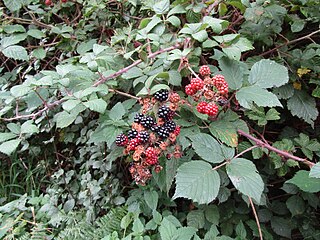
An embryo is the initial stage of development for a multicellular organism. In organisms that reproduce sexually, embryonic development is the part of the life cycle that begins just after fertilization of the female egg cell by the male sperm cell. The resulting fusion of these two cells produces a single-celled zygote that undergoes many cell divisions that produce cells known as blastomeres. The blastomeres are arranged as a solid ball that when reaching a certain size, called a morula, takes in fluid to create a cavity called a blastocoel. The structure is then termed a blastula, or a blastocyst in mammals.

Rubus is a large and diverse genus of flowering plants in the rose family, Rosaceae, subfamily Rosoideae, with over 1,350 species, commonly known as brambles.

Convolvulaceae, commonly called the bindweeds or morning glories, is a family of about 60 genera and more than 1,650 species. These species are primarily herbaceous vines, but also include trees, shrubs and herbs. The tubers of several species are edible, the best known of which is the sweet potato.

Plantaginaceae, the plantain family, is a large, diverse family of flowering plants in the order Lamiales that includes common flowers such as snapdragon and foxglove. It is unrelated to the banana-like fruit also called "plantain." In older classifications, Plantaginaceae was the only family of the order Plantaginales, but numerous phylogenetic studies, summarized by the Angiosperm Phylogeny Group, have demonstrated that this taxon should be included within Lamiales.

Nyctaginaceae, the four o'clock family, is a family of around 33 genera and 290 species of flowering plants, widely distributed in tropical and subtropical regions, with a few representatives in temperate regions. The family has a distinctive fruit type called an accessory fruit or anthocarp, and many genera have extremely large pollen grains.

Eucalyptus placita, commonly known as grey ironbark or simply, ironbark, is a species of small to medium-sized tree that is endemic to New South Wales. It has rough, furrowed grey but soft ironbark on the trunk and branches, glossy green, lance-shaped adult leaves, flower buds in groups of seven, white flowers and conical fruit.
The plains minnow is one of the 324 fish species found in central United States. It is a large minnow that was once a common bait fish. The plains minnow requires shallow, slow-moving streams to complete its life cycle. Pollution, dams, and introduced sport fish have caused populations to decline.

iNaturalist is an American 501(c)(3) nonprofit social network of naturalists, citizen scientists, and biologists built on the concept of mapping and sharing observations of biodiversity across the globe. iNaturalist may be accessed via its website or from its mobile applications. iNaturalist includes an automated species identification tool, and users further assist each other in identifying organisms from photographs. As of 9 July 2024, iNaturalist users had contributed approximately 197,660,888 observations of plants, animals, fungi, and other organisms worldwide, and 290,007 users were active in the previous 30 days.
Teretrius montanus is a species of clown beetle in the family Histeridae. It is found in North America.

Abraeinae is a subfamily of clown beetles in the family Histeridae. There are at least 20 genera and at least 440 described species in Abraeinae.
Teretrius is a genus of clown beetles in the family Histeridae. There are at least 70 described species in Teretrius.

Aulonothroscus is a genus of small false click beetles in the family Throscidae. There are more than 20 described species in Aulonothroscus.

Melanoliarus placitus is a species of cixiid planthopper in the family Cixiidae.

Teretriini is a tribe of clown beetles in the family Histeridae. There are about 5 genera and more than 90 described species in Teretriini.
Teretrius cylindrellus is a species of clown beetle in the family Histeridae. It is found in North America.
Teretrius orbus is a species of clown beetle in the family Histeridae. It is found in Central America and North America.
Teretrius latebricola is a species of clown beetle in the family Histeridae. It is found in North America.
Chrysotoxum chinook is a species of syrphid fly in the family Syrphidae.
Animal Ethics is a nonprofit organization formed to promote discussion and debate around issues in animal ethics and to provide information and resources for animal advocates. They also do outreach work in several countries on the issue of speciesism. Their aim is to create a world where moral consideration is extended to all sentient beings. The organization's website covers topics such as speciesism, sentience, veganism and wild animal suffering and has content translated into several languages.

Podothrips is a genus of thrips in the family Phlaeothripidae.











